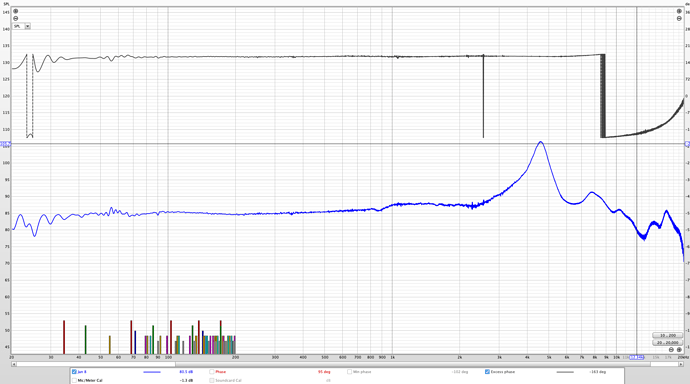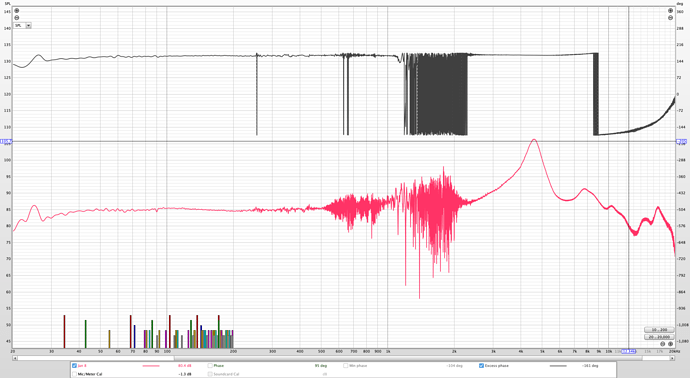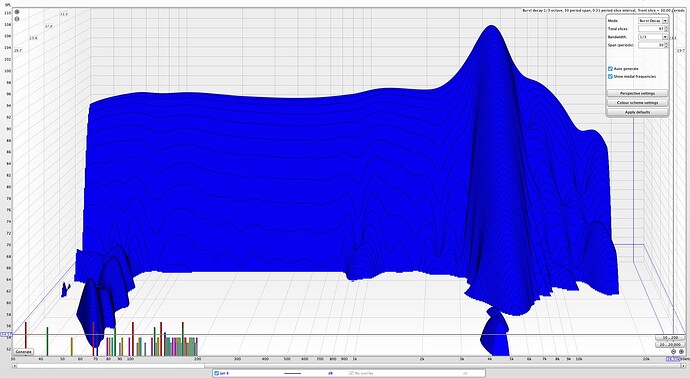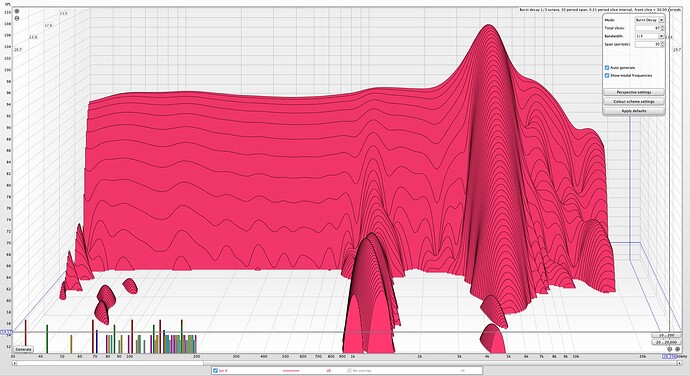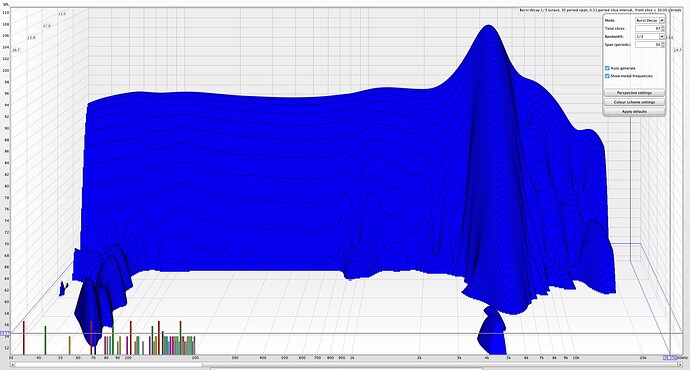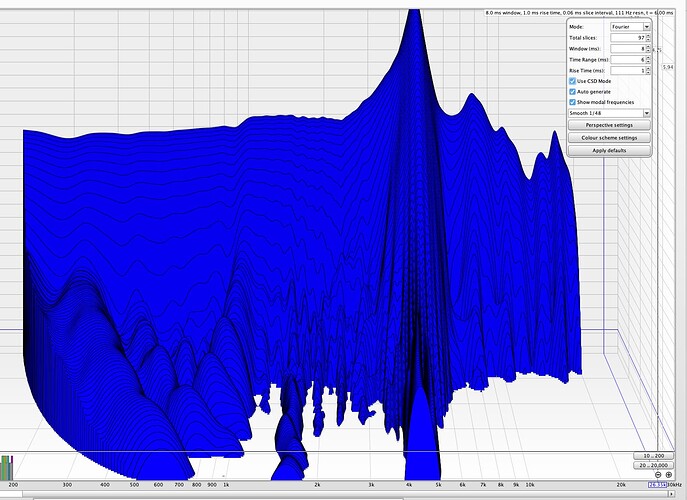I have seen @ProfFalkin sharing some CSDs here before - he might be able to advise on best practices
There’s actually a helpful reddit wiki on this topic here:
Essentially the main problem is that it looks meaningful, but in reality it’s just a more difficult way to look at FR. I especially like Chocomel’s statement in the conclusion here:
“When people say a headphone has poor decay it doesn’t mean they are just wrong though, Decay is also a subjective descriptor and people don’t always mean the measurable kind. Just because people attribute what to hear to the “wrong” measurement doesn’t mean that what they hear isn’t there.”
To me this is also the key problem with CSD, it looks like something that may also be a real acoustic property that we’re not currently identifying with FR. But that doesn’t mean it actually is that thing.
This is a great example of how a lot of headphone reviews can really confuse people. Decay is an aspect of instrumental timbre, not a property of a transducer. It doesn’t really make sense to talk about a headphone’s decay.
What does make sense is to discuss whether a headphone can properly reproduce decay as present in a recording, and I suspect that mostly comes down to frequency response. For example, closely related to decay is reverb. The LCD2C has this lovely way of highlighting reverb that’s great for church music, a characteristic that some people call wet. I scrutinized the hell out of CSDs and impulse responses trying to figure figure out what accounts for this, but at the end of the day what it comes down to is the headphone’s elevation around 1KHz combined with a fairly flat response below that and relatively subdued treble above.
With this, we’re back to the idea that a lot of what we hear subjectively does in fact come down to frequency response, but that doesn’t mean it’s easy to look at a graph of frequency response and understand all aspects of how it influences playback of recordings. It also doesn’t mean that equalizing everything to the same target is going to sound identical. The 1KHz elevation on the LCD2C was only 1-2dB, and getting the on ear response for two different headphones to match that closely on a random person is going to be pretty danged hard, especially without instrumentation.
Yup, exactly. But it also gets super challenging when you have that extreme blunting going on with something like the Panda. It totally lops off any nuances that may exist there in the music. I have yet to find a way to fix that issue. So, my suspicion is that while we may have a major portion of it figured out with FR, there’s a lot about transducer performance and how it’s subjectively received that we still need to investigate.
Interestingly your impression mirrors Amir, who couldn’t enjoy the Panda even after EQ. Also interestingly, the distortion performance on the Panda is actually quite good, so that doesn’t explain it.
Rtings scores the Panda very poorly for frequency response consistency, so maybe part of what’s going on here is that it’s just very difficult to EQ it well?
Are you saying that the CSD plots don’t reflect things like ringing and unwanted resonances?
IIUC, for headphones that are minimum phase, a CSD plot doesn’t contain any information that’s not present in the frequency response, so what looks like ringing on a CSD will just be a peak or null on the frequency response.
There are apparently outliers that don’t behave as minimum phase devices at particular frequencies, for which CSDs seem useful, but excess group delay can show the same thing even more clearly.
In general, I would love to see excess group delay in headphone reviews as a nice sanity check for weird driver behavior. 
Here is a decent discussion of it:
Post in thread ‘Audeze LCD-X Over Ear Open Back Headphone Review’ Audeze LCD-X Over Ear Open Back Headphone Review | Page 16 | Audio Science Review (ASR) Forum
Rather, they don’t show anything that isn’t already in FR, except in particularly rare cases where a headphone might not be minimum phase.
Yeah, that’s what I was doing before I got those in-ear ones. Good luck!
OK, so can we for any FR construct one and only one CSD plot?
in what case would a headphone not be minimum phase (what makes a headphone minimum phase)?
As far as I understand it, it’s not uncommon for IEMs to not be, although I welcome more info on that front. Other than that, I still think it might be worth probing the qualification for minimum phase a bit, and that’s where I’m out of my depth. But I’m imagining a potential situation where time domain information is only mostly proportional to FR information, and where fixing the issue in FR only lessens the effect in time domain or something like that. So I suppose it’s still worth looking at CSDs for those cases, but the main point is to not look at CSDs for anything to do with the subjective qualia that they appear to indicate - or in other words… resonances = FR, and not ‘transient linger’ or ‘decay’ or elements of the experience like that.
The REW documentation has some very useful explanations of minimum phase in the context of measuring in room speaker response and generating corresponding EQ. The documentation gives some useful examples of things that would cause an audio system to deviate from minimum phase behavior, one of which is sound being reflected and focused by a curved surface.
In the context of headphones, I believe an example of something that would deviate from minimum phase behavior is if you have some material on the device that resonates at an audible frequency. When the driver plays that frequency, the material will amplify that frequency by resinating with it, and will continue to vibrate at that frequency even after the driver stops playing it. That would show up on a CSD as extended ringing, but would show up even more clearly on an excess group delay graph.
https://www.roomeqwizard.com/help/help_en-GB/html/minimumphase.html
Here’s a contrived demonstration. I measured my HD58X on a MiniDSP E.A.R.S. This first is just a normal measurement.
The black line shows the excess phase, which highlights regions where the measurement is deviating from minimum phase behavior. As you can see, in this test, the HD58X is generally well behaved, with a little bit of trouble in the lowest bass and something going on at about 2.5 KHz, which might just be the measurement fixture.
For the next test, I ran the same measurement again, but this time I clapped my hands when the frequency sweep got to around 1 KHz.
In this test, the extra sound that I fed into the system with my clap caused the measured output of the system to deviate substantially from the input signal, not just in amplitude but also in phase (since the output of my clap wasn’t synchronized with the sweep). You can see that disturbance clearly in the excess phase graph.
You can also look at this in terms of burst decay (like a CSD but in period cycles rather than time)
Good
Bad (nonsense at 1 KHz is clearly visible)
As a bonus, here’s a visual explanation of one of the ways in which the CSD can be misleading.
Burst Decay
CSD
-
It looks like there’s something wrong at 4 KHz because of that long decay trail, but there’s not, the amplitude is just much higher there.
-
In the CSD, it looks like the bass decay is relatively poor compared to the treble. But that’s misleading, because the CSD shows decay in units of time. If the decay in number of cycles is constant across the frequency range, a 400 Hz signal will take 10 times as long to decay as a 4 KHz signal. I used to use CSD, but going forward I’ll definitely stick with burst decay because it doesn’t have this problem.
And here is the problem with lists! Inconsistency! Your review (and others) of the Hedd Headphone informed my decision to buy a pair, and I have been extremely happy with them. Yes the comfort/weight for some may be off putting, but sonically they are unmatched for the price. I find it quite strange that you call them tier 3 when you have the LCD 4 in Tier 1 (with EQ). In your Heddphone review you said it was superior (or at least level with) the LCD 4 in most categories. Both are heavy and not really viable for long listening sessions. So if the Headphone is sonically equal to or better than the LCD 4 at 1/2 the price…how can you list it in your Tier 3, v’s Tier 1 for the LCD 4? Your Heddphone review stated that it was the new headphone to beat, and at less than $2k was the new benchmark that other high end headphones had to beat to make any sense? Sounds like you backtracked bigtime!
The LCD-4’s weight is an issue yes, but I personally find it easier to wear due to the wider headband. I think if the HEDDphone had a wider headband it would be in a higher tier at least. Also, for those who don’t EQ, the HEDDphone absolutely has a better tuning than the LCD-4, and for the rest of its sound quality, when driven appropriately I would take it over just about everything under $2k… if not for the comfort. And yes, that includes the LCD-X 2021 and others like the Arya stealth and so on. While I’m absolutely guilty of hyping it up (something I’m doing my best to avoid doing in the future), I don’t think my view of it has changed much.
But… to the larger point, my view of many products has changed over time. The more you learn, the more experience you get with different equipment, the more you learn what things can sound like at a given price point. Hell, I’ve personally owned the AQ Nightowl in the past and that’s a headphone I’d never recommend today haha. So yeah, opinions can change, even if not in this particular instance.
In many ways this is why I didn’t want to do a ranking list like this, because people are bound to think a lower tier = categorically worse. And maybe that’s true in some cases, but really it’s not intended to validate or invalidate anyone’s purchases. Rather, it’s to give an indication of my personal preferences and priorities for headphones. But maybe that requires too much qualification, again still on the fence about keeping this list up.
Can you elaborate more on what you meant by your comments about the LCD-5s VS the CRBNs?
You mention if it were a higher priority for you, they’d be a stronger consideration. I’m not sure if you’re saying that you don’t like them in comparison because you haven’t spent time with them? Really unsure overall here.
And, did you EQ the CRBNs (and if so, can you share that)?
I mean if ‘timbre’ were a higher priority for me. And yeah while the CRBN had it’s strengths in that department, I found the lcd5 to be better at the things I cared more about. And yes, I ended up EQing both over time.
Nicely and politely put, I would have said “my list, my rules, you’re welcome to create your own”. I really don’t get this “you’re wrong” mentality.
